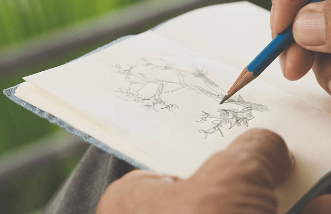- Verve Newsletter
- Posts
- Drawings and learning
Drawings and learning
How drawing helps us to memorize
Hello Enthusiastic of knowledge!
How’s everything going?
Today we unleash a bit of creativity in our study days!

Our memory if primarily visual
Unfortunately, in our conception of studying and the study method that has always been taught to us, the key element for our memorization is often missing: images.
In fact, our memory is primarily visual. The human brain is naturally predisposed to recognize and remember images better than words or numbers.
Yet, we insist on assimilating information by reading and repeating written phrases. A bit absurd, isn't it?
Think about it this way: why does the “read and repeat” method work? If you pay attention, while you repeat the information, you are creating images in your mind, and when you have memorized the information, you often realize that you have created images associated with that information.
Our memorization largely happens this way! We associate information with images and images with pre-existing knowledge from our experiences. Information connected in this way supports each other in our memory.
Once we become aware of this, we can deduce that if we directly memorized images, we could save all the time we spend waiting for our brain to create images for us and memorize much more quickly.
And it is indeed so!
By memorizing through images, our memorization is much faster. Even in world memory championships, images are memorized!
Do you think those champions who memorize long series of numbers actually memorize the numbers? Most of them are actually memorizing images using specific techniques.
And even though they are particularly trained, you too can drastically improve your memory by using images.
Here are two simple techniques that will help you in your studies:
SketchMemo
This first technique is very simple, but also very effective.
It involves taking a notebook or a whiteboard (personal preference) and, when you memorize a concept or some information, creating small sketches of what you are memorizing.
For example, if I am memorizing the list of tasks of an HR manager in an organization, I can create something like this:

As you can clearly see, the roles of an HR manager include training and development of employees, performance appraisal, preparing HR planning and manpower planning, rewarding employees, and marrying employees and employers ( hemm…..managing employer-employee relationships, clear)
It may seem trivial, but these small sketches are truly helpful for our memory. Additionally, drawing while you memorize keeps you much more active, makes memorization less boring, and boosts your energy levels.
Metaphoric drawings
The second technique is an evolution of the first one.
This technique is used to understand and memorize complex concepts. When you need to study a complex concept or something you can't remember, create a metaphorical drawing for the concept.
Create visuals, even abstract and metaphorical, for the various parts of the concept and create a visual representation of the concept as a whole using these small visuals.
Essentially, create an abstract drawing that reminds you of the concept you are studying.
This is an excellent way to understand and process information effectively, as well as to memorize it very quickly. By remembering the drawing you made, you will recall the entire concept.
I hope these techniques are useful to you and bring some creativity and new energy to your study sessions.
And may this new perspective on memory be helpful to you.
Have a great week!
Isa